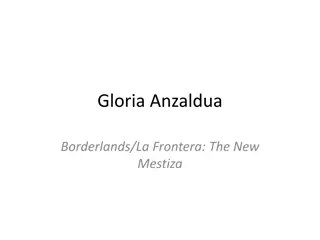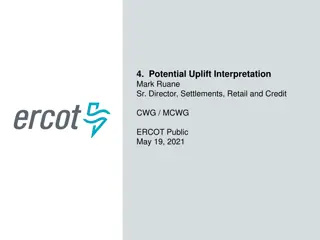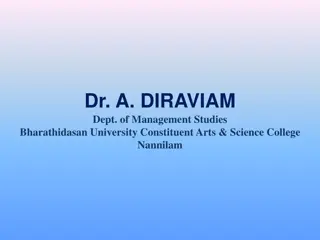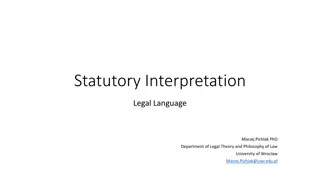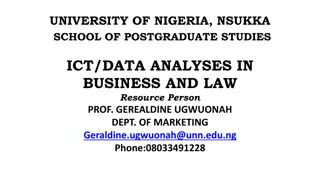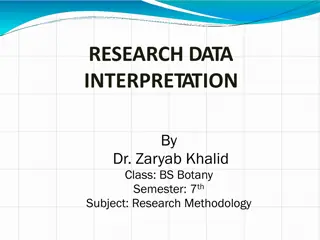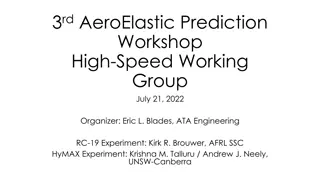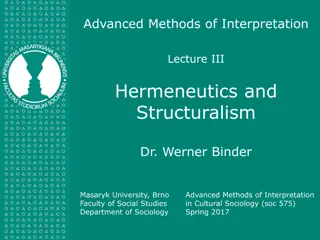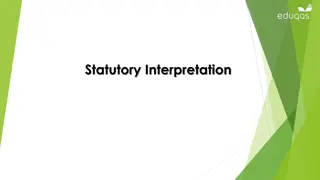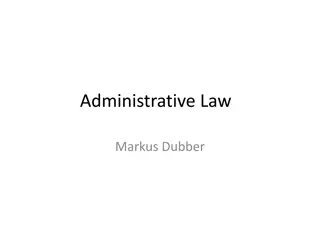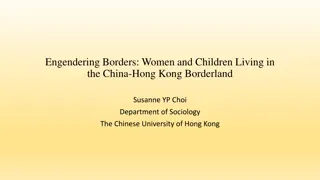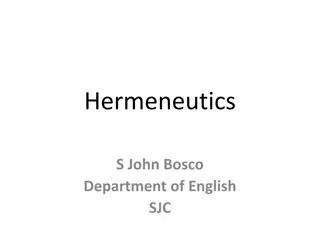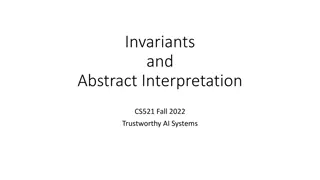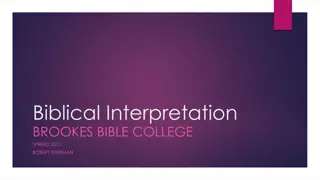Anzald.a's Borderlands Interpretation Workshop: Group Study & Analysis
Explore Anzald.a's text through group activities, discussions, and interpretation methods focusing on key concepts such as borderlands, mythologies, psychology, and literature. Understand the importance of reader-response in deciphering the implied relationships and implications within the montage of subjects presented by Anzald.a. Embrace the rich tapestry of languages, styles, and genres in her work to delve deeper into the complex layers of identity and experiences at the borders.
Download Presentation

Please find below an Image/Link to download the presentation.
The content on the website is provided AS IS for your information and personal use only. It may not be sold, licensed, or shared on other websites without obtaining consent from the author.If you encounter any issues during the download, it is possible that the publisher has removed the file from their server.
You are allowed to download the files provided on this website for personal or commercial use, subject to the condition that they are used lawfully. All files are the property of their respective owners.
The content on the website is provided AS IS for your information and personal use only. It may not be sold, licensed, or shared on other websites without obtaining consent from the author.
E N D
Presentation Transcript
Anzalda Slide Show CRTW 201 Dr. Fike
Texts You must have Anzald a s texts in order to participate today. If you do not, go get them. You may rejoin the class in progress.
Questionnaire Please take a moment to fill out the handout.
Group Work: Points of View Do some thinking about this question: What argument is Anzald a making about borderlands with respect to the following sub-topics? Use as many elements as you can as you discuss and analyze. Group 1: Biological stuff (snake, tongue, bodies, etc.). Be sure to cover the opening poem on 72 and the cobra on 79. Group 2: Mythology and anthropology (especially Guadalupe), pages 73-78. Group 3: Psychology (psychic functioning): Your job includes 79-83. Group 4: Literature/academia (especially How To Tame a Wild Tongue, 85-93).
The Method The Method is particularly well suited for today s chapters. What repeats? (patterns like the word "snake") What goes with what? (strands like things that are psychological) What is opposed to what? (binaries, T chart below) What doesn't fit? (anomalies like multiple languages and poetry) Re. all of these questions: So what?
Overview Today we are going to do an exercise in interpretation. It partly involves a technique from WA called collapsing the binary.
Preliminary Remarks Anzald a s chapters are a montage, which means a mixture of subjects, languages, styles, and genres. In other words, her format is to TEXT what John Berger s collages are to images (his book is called Ways of Seeing). In each author s case, juxtaposition is important. Relationships are there, but our reader-response is a key part of the interpretation. In other words, implications are evoked in us rather than being directly stated in the text. We supply the missing links.
The Key Concept Write down in your notebook what you think is the key concept in Anzald a s chapters. The answer is on the next slide.
The Key Concept Borderland: borderland : the region on both sides of the Texas- Mexico border Borderland includes other types of Borderlands such as psychological, sexual, and spiritual. Find the definition in par. 1 of the head note on page 70 and write it in your notebook. Then do an SEE-I for it. Half of you do borderland; the other half, Borderland. My SEE-I is on the next slide.
SEE-I S: A borderland is a geographical place where cultures and classes meet and interact. E: In other words, it is an interface between opposite or adjoining cultures. E: For example, the area along the US/Mexico border participates in both countries cultures. I: It s like brunch, which combines elements of both breakfast and lunch, a little of both, but is not purely one or the other. Or: It s like the middle section of a venn diagram where categories overlap.
Problem There is a problem with my SEE-I, though. Write down in your notebook what you think it is. How is it insufficient (that is, not enough)? The answer is on the next slide.
Problem The SEE-I does not capture the idea that one of the cultures has more power than the other. In other words, there is an imbalance: one culture is dominant (hegemonic); the other is subordinate (subaltern). This power dynamic is very much present in Anzald a s thinking. I intend the next slide to help you understand that Anzald a s text is based on what WA calls binaries. Copy the terms in your notebook and complete the exercise by adding the subordinate pieces. Distribute grid handout.
What Goes with These Concepts? Mind Body Human Animal Male Female Light Dark Spanish Aztec Aztec Nomadic tribes Rationality Spirituality Reason Imagination Western Non-Western Europe New world Empiricism Psychic functioning / La facultad American Mexican Mexican Chicano Christian Pagan Class system Tribal society
Caveat The interpretation on the next slide does not characterize the views of Dr. Fike, the Department of English, or Winthrop University. The next slide simply explains the preceding slide in order to help you understand what the author is saying.
Here Is Another View Aztecs > nomadic tribes :: Spanish > Aztecs :: Americans > Mexicans :: Chicanos > blacks. The Aztecs are superior (in terms of power) to nomadic tribes, as the Spanish are superior to the Aztecs, and as the Americans are superior to both Mexicans and Chicanos, as those folks are presumed to be superior to blacks. That is the reality that Anzald a is addressing. She is not saying that it is morally right; she is just giving an accurate summary of her perception of race relations. POINT: In a borderland, the meeting of opposites reflects asymmetrical power relationships.
Anzaldas Purpose Her purpose is to subvert these binaries by doing a kind of FEMINIST DECONSTRUCTION. Feminist means that the objective is to elevate the position of women and others in subordinate positions. Deconstruction means that this goal is achieved not, in this case, by flipping binaries but by merging them showing the common ground. So her goal is what she calls balanced duality on page 78 (last par.: mark your text). This point is in the spirit of the well-known statement that the whole is greater than the sum of the parts.
In Other Words Anzald a wants to advocate for greater recognition of those things that exist in the subaltern position, the secondary or subordinate position (second column of your chart). She wants us to think not in terms of binary oppositions (negations) that involve hierarchy that is, black-and-white thinking but in terms of pairings that can coexist without the need for subordination (contraries, antinomies). Difference is not deficiency. Thus, her goal is to bring the things in the right column into sync with those in the left column so that a new third thing a hybrid is produced. She seeks to bridge or balance the paired terms so that power is more equal. There is a clear political purpose here: she hopes to effect political change.
Writing Analytically 94-97 Page 95: Discover that the two terms of your binary are not really so separate and opposed after all but are actually parts of one complex phenomenon or issue. (This is a key analytical move known as collapsing the binary. ) Page 97: This move is known as collapsing the binary: coming to see that what had appeared to be an opposition is really two parts of one complex phenomenon.
Okay, But How? I mentioned earlier that reader-response is very important here. The assumption is that Anzald a s readers are people like us: from the dominant culture, English- speaking, and mostly white. How did you all feel when you had to read a text that included untranslated words in a foreign language? Anzald a is attempting to give you the experience of being in a subordinate position in a borderland. She simultaneously evens the power relationship between dominant, mostly white, English-speaking culture and her own subordinate, Chicana, Spanish-speaking culture. The result is the text, a new third thing that bridges binary oppositions and leads to a new hybrid state in which new possibilities arise. That is her hope anyway. She seeks not just to elevate the items in the right column of the chart but also to merge the left and the right columns in a new and creative way. In this fashion, she attempts to bring enhanced positive attention to the borderlands. Your reader-response is that new third thing that is greater than the sum of its parts. It is neither purely English nor purely Spanish but a hybrid/montage of both.
The New Third Thing In attempting to work out a synthesis, the self has added a third element which is greater than the sum of its severed parts. That third element is a new consciousness a mestiza consciousness and though it is a source of intense pain, its energy comes from continual creative motion that keeps breaking down the unitary aspect of each new paradigm (Borderlands 101-02). Mestiza consciousness: a holistic, both/and way of thinking and acting that includes a transformational tolerance for contradiction and ambivalence (Keating and Gonz lez-L pez, Glossary ).
Anzalda Herself Is That New Third Thing She is a lesbian Chicana. As a lesbian, she considers herself to be both male and female. As a Chicana, she is halfway between English and Spanish. She is a bridge figure, as she indicates on page 92: Deep in our hearts we believe that being Mexican has nothing to do with which country one lives in. Being Mexican is a state of soul not one of mind, not one of citizenship. Neither eagle nor serpent, but both. And like the ocean, neither animal respects borders (emphasis added).
Anzalda Is a Guadalupe Figure See pages 75-76. Anzald a is a Basque name, where an means above, the upper worlds, the sky, the spirit [eagle]; zal means the underworld, the world of the soul, of images, of fantasy [serpent]; and d a is the bridging of the two; and the bridge, to me, is the interface ( Creativity 103). I span abysses, she states in La Prieta (209).
The Juan Diego Story See today s handout online for the J. D. story.
Binaries Juan Diego, who shuttles back and forth between Tepey c (also called Guadalupe) and the bishop s location, acts as a bridge and signifies nepantla. Through his in-between agency, binaries meet and start to interact: upper and lower classes, city and country, male and female, human and divine, the bishop s intellect (eagle) and the virgin mother s several numinous appearances as well as her miraculous cure of Juan s dying uncle (serpent).
Homework You have two things to think about for next time: Read it if you have not done so already. Group work (next slide). Sacred cows: Did Anzald a tip over any of yours? Consider the questions two slides below. (This slide is a bit like Tart s Western Creed Exercise. )
Group Work: Points of View Do some thinking about this question: What argument is Anzald a making about borderlands with respect to the following sub-topics? Use as many elements as you can as you discuss and analyze. Group 1: Biological stuff (snake, tongue, bodies, etc.). Be sure to cover the opening poem on 72 and the cobra on 79. Group 2: Mythology and anthropology (especially Guadalupe), pages 73-78. Group 3: Psychology (psychic functioning): Your job includes 79-83. Group 4: Literature/academia (especially How To Tame a Wild Tongue, 85-93).
Sacred Cow Exercise: Assumptions Did Anzald a's text activate any of your own FBIs? Extract assumptions from Anzald a s two chapters (those she believes to be accurate as well as those she wants to overturn). List as many as you can and write them on the white/black boards. You might well begin with the section on which your group reported. Then ask yourself this question: At what points did you feel yourself pushing back? Why? What sacred cows did Anzald a violate for you as a reader of her text? Think back to Tart s Western Creed Exercise as you work back through the two chapters. How did your body and emotions FEEL as you read her chapters? Finally, did you find any fallacies in her material any places where she violates the spirit of her own project? Here are some prompts re. assumptions; feel free to add your own to this list.
Here Are Some Areas of Inquiry To Get You Started The study of literature The spirit world Psychic ability, the suprahuman North American culture Borders Language Women and minorities Feminism and feminists Standard English Cultural hegemony The body The unconscious mind The soul
Clarification The statements on the next slide do not represent the positions of Dr. Fike, the Department of English, or Winthrop University. They are designed to help you think about what you think and to explore why you think it.
Sacred Cows (Assumptions) We should study literature by white men in Western tradition (the Western canon). There is no spirit world or, if there is, we cannot access it while we are alive (or we CAN access it, but it is dangerous, demonic). We are not psychic. Psi is not real. White North American culture is the best. Borders should be respected. We are not equal to our language. It is just a tool. But everybody should speak standard English. Women and minorities should keep silent. Feminists are man haters and lesbians. Cultural hegemony (superiority, authority) is ours because we are better. Americans are born with special privileges. The body is bad.
Traits The critical-thinking character traits (habits of mind) appear on pages 175-76. In what ways does Anzald a illustrates these traits? Confidence in reason Intellectual humility Intellectual courage Intellectual empathy Intellectual integrity Fair-mindedness Intellectual engagement Intellectual perseverance Intellectual autonomy
Final Application What things from Anzald a s two chapters might help you write your final paper about a global cultural event?
Evaluation: Standards Here is a bit of evaluation to consider. There are fallacies on page 81: all violence all life, beauty, pleasure totally ignore the soul By overgeneralizing, is Anzald a violating the spirit of borderlands consciousness, which seeks to bring oppositions together? Isn t she doing, say, to Christianity the thing she attacks Christianity for doing to native religions? Isn t this dualism/hierarchy rather than duality/unity? What standards is she violating?
SEE-Is Do an SEE-I for the following terms: Identity, 91 The unconscious Soul The suprahuman (supra = above or beyond) Mediatrix La Facultad END



